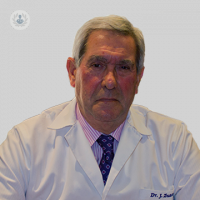Cardiac pacemaker, types and operation
Written by:A pacemaker is an electronic device designed to solve certain heart rhythm problems by generating electrical impulses capable of stimulating and producing contractions of the heart, adapting them to the needs of the patient whose autonomous pulse-generating heart system is damaged by different causes.. The pacemaker is made up of a metal casing that is little larger than a wristwatch, which contains complex electronic circuits and a battery (generator), and one or more electrodes (cables) that, from the generator, reach inside the heart. through veins, and transmit to the heart impulses generated inside the housing.
Heart problems that make it necessary to have a pacemaker
In general, pacemakers are indicated for heart rhythm disorders that produce an abnormal decrease in heart rate, and there are mainly two causes: Sinus node dysfunction (in which cardiac impulses originate) producing absence or decrease of heartbeats , or the failure to drive the impulses to the heart muscle. Additionally, some atrial arrhythmias with slow ventricular response can produce cardiac symptoms that are resolved with the placement of a pacemaker. Finally, there are arrhythmias that produce a very fast heart rate. In such cases, a part of the autonomous conduction system can be "burned" to avoid tachycardia, after implantation of a pacemaker that guarantees the contraction of the ventricles.

Pacemakers, risks and complications
Early complications are very rare. At the time of pacemaker insertion, arterial and venous lacerations, pneumothorax, and ventricular perforation with or without cardiac tamponade may occur, assuming an incidence of less than 1% among all of them.. Later, dislocation of an electrode may occur which involves the need for repositioning, thrombosis of the arm veins, and wound problems of which the most important is infection, which requires removal of the system. These later complications are also very rare.
Duration of a pacemaker
Depending on the type of pacemaker installed, and the need for it by the patient, the average life of pacemakers varies between 6 and 11 years approximately : On the one hand, the most sophisticated pacemakers, in general consume more energy and its hard battery less time. On the other hand, if all the beats are produced by the stimulation of the pacemaker (the patient does not produce beats spontaneously), obviously the battery will be depleted more precociously. Once in the controls that are performed periodically interrogating with an external device the pacemaker itself, it is detected that the remaining life of the pacemaker is less than 3-4 months, the change of the generator that is made electively is indicated, and it consists of in surgically exposing the device with local anesthesia, disconnecting the generator from the electrode, and connecting a new generator to the same electrode, closing the wound when it is verified that the system is functioning correctly.
Pacemaker placement
As indicated above, when a type of arrhythmia susceptible of being treated with a pacemaker is detected, it is essential to specify the type of device to be implanted in order to guarantee the most physiological functioning possible of the heart.. Once the type of pacemaker is decided, a small incision with local anesthesia must be installed in the heart through the veins next to the clavicle, one or two electrodes with radioscopic control.. Once the electrodes are installed, it is verified that the electrical parameters of the electrodes are adequate, they are connected to the generator and the surgical wound is closed.
Pacemakers, postoperative care
Before the intervention, as far as possible, coagulation should be normalized (most patients requiring pacemakers follow anticoagulant or antiplatelet therapy) to reduce bleeding complications and wound hematomas that could be a problem by themselves and by suffering secondary infection. After implantation, patients should be reviewed on an outpatient basis to adapt the energy consumption of the pacemaker to the parameters analyzed with the external programmer / analyzer, and to prolong the life of the device as much as possible.. The vast majority of patients with pacemakers resume their normal activities within a week. However, they should avoid any sudden physical contact in the area of the pacemaker as the cable or device could be damaged. Treatments for diathermy, magnetic resonance imaging (except in compatible models), and transurethral ablation with needle should be avoided.. In general, it is recommended that, before undergoing any clinical procedure, the specialist who is going to perform it be instructed to carry a pacemaker since some procedures may affect the operation of the pacemaker.
Finally, patients who are implanted with a pacemaker should be provided with a "patient's guide for a pacemaker" issued by the Spanish Agency for Medicines and Health Products, which will clarify almost all of their doubts.


